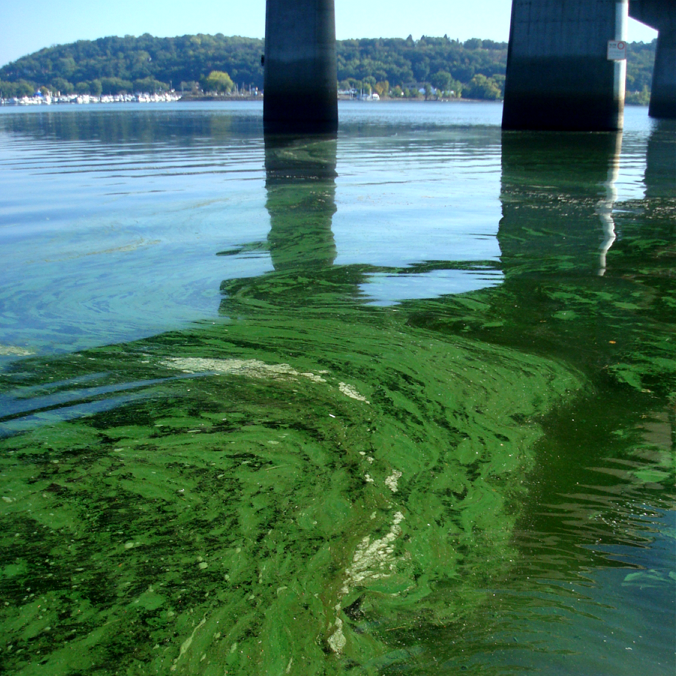Fast Facts about the River
You know that blue-green or green algae you see on the surface of the water? It can actually be extremely harmful to humans, as well as other creatures living in and around the river. Technically the algae is known as cyanobacteria and can produce three different types of harmful toxins: dermatoxins (skin toxins), hepatoxins (liver toxins), and neurotoxins. These poisons can cause muscle cramps, twitching, vomiting, diarrhea and, in severe cases respiratory, cardiac, or liver failure, paralysis, and even death.
Ways to Protect the River
Control fertilizer and septic tank run-off to reduce damaging algae blooms (to learn more, visit http://tinyurl.com/hpsms83).
The St. Croix River Association is dedicated to preventing the spread of aquatic invasive species as we protect, restore and celebrate the St. Croix River and its watershed.
Learn more about our programs and ways you can get involved by visiting our website at stcroixriverassociation.org.
BLUE-GREEN ALGAE Q&A FOR WATER SYSTEM OPERATORS
Q: What are blue-green algae?
A: Blue-green algae, technically known as cyanobacteria, are microscopic organisms found naturally in lakes, streams, and ponds. These algae are actually a primitive form of bacteria capable of photosynthesis. When present in large numbers they may form visible green, blue-green or reddish-brown blooms that float on the surface of the water.
Q: What are the health risks from blue-green algae?
A: Blue-green algae produce three types of toxins: neurotoxins, hepatotoxins, and dermatoxins (skin irritants). Neurotoxins affect the
nervous system. Symptoms include muscle cramps, twitching, and in extreme cases paralysis, cardiac or respiratory failure, and death. Hepatotoxins affect liver function. Symptoms include nausea, vomiting, diarrhea and, in extreme cases, even acute liver failure. The World Health Organization (WHO) has established a health-based drinking water guideline of 1.0 ppb for one algal toxin, Microcystin-LR. The Australian standard is 1.3 ppb for total microcystins, while Health Canada has proposed a similar standard of
1.5 ppb for total microcystins. Algal toxins are on the U.S. Environmental Protection Agency’s Contaminant Candidate List for consideration of future regulation.
Q: Are algae an issue for water systems?
A: Yes. Algae are present in all surface waters and excessive growths can cause taste and odor problems, create difficulties for water filtration and pose potential health risks. There are a number of different types of algae. The ones of greatest concern
are blue-green algae because they can produce toxins that may be harmful to human health.
Q: What can we do if we suspect blue-green algae are in our source water?
A: First, monitor and sample. Not all blue-green algae produce toxins and among those that do, toxins occur only a portion of the time. There are a number of labs in Oregon and throughout the country that can identify algae species and provide density counts. This type of analysis usually costs $60 to $125, depending upon the type of analysis and requested turnaround time.
NOTE: If a visible bloom is present, treat it as potentially harmful and use algaecide very carefully. Algaecide can cause the algae to rupture and release toxins into the water. Toxins are more difficult to remove when they are outside the cell than when contained
within it. Also, if you decide to use algaecide, consider switching to another water source while treatment is underway. Use only NSF International™ approved algaecides.
Q: Can our water treatment plant remove blue-green algae and algal toxins?
A: Yes. Water treatment plants are capable of removing microorganisms much smaller than algae. Removing the algae will remove most associated toxins since growing intact cells contain 70 to 100 percent of the toxins. When cells rupture or die, they tend to release the toxins into the water. Effectiveness of the water treatment process will vary depending on the type of treatment and algae.
To improve the removal of algae and their toxins:
- Minimize preoxidation – Preoxidation with chlorine and ozone can cause algae cells to rupture, thus releasing toxins. (In some cases, preoxidation will be necessary to meet Giardia and virus inactivation requirements, so preoxidation can only be reduced and not eliminated.)
- Adjust coagulation, sedimentation, and filtration – Careful monitoring and adjustment of coagulation and filtration processes may improve algae removal. Intact cells removed by these processes will significantly reduce the possibility that toxins will be present in the finished water.
- Don’t recycle backwash water – Backwash water can contain high concentrations of algae that may rupture and release toxins.
- Adjust post-filtration disinfection – Once the algae cells are removed from the water, soluble toxins can be destroyed by chlorine and ozone, which are strong oxidants. Effectiveness varies depending upon the dose and the algal toxin. Microcystins can be destroyed by free chlorine at a dose of 0.5 mg/L for 30 minutes and a pH of less than 8.0. Post-clarification ozone can destroy microcystins, nodularin, and anatoxin-a when the dose is at 2.0 mg/L. Activated carbon has also proven to remove many soluble toxins very well at a dose of 25 mg/L with a contact time of 30 minutes. Some other algal toxins are more resistant to oxidation, so longer contact times and higher doses are required before significant destruction will occur. The references cited at the end of this Q&A are recommended sources for more detailed information on water treatment processes to remove algae and their toxins. Other solutions include relocating the intake and using powdered activated carbon (PAC), granular activated carbon (GAC), or ozone in the water treatment plant. Both PAC and GAC are capable of removing algal toxins from the water, while ozone is a more powerful and effective oxidant than chlorine. Effectiveness of these processes depends on the type of toxin and other parameters.
Q: What should we do if blue-green algae are detected?
A: Make any necessary adjustments to your treatment process. Also, consider sampling for algal toxins. The type of toxins produced will vary with the type of algae as summarized below: There are a limited number of labs that analyze for algal toxins but some can only analyze for microcystin. Cost varies from around $300 to $500, depending on the type of analysis and requested turnaround time.
Q: How can we prevent future algae blooms?
A: Blue-green algae thrive in warm, stagnant waters that have significant concentrations of nutrients. Phosphorus is frequently a limiting nutrient. Steps should be taken to control phosphorous from entering the water body through fertilizer runoff, septic systems, and other sources. Additional prevention techniques include increasing water flow through the lake or reservoir, artificial circulation of water within the reservoir and improved watershed management. Nutrient reduction and watershed management activities may take years to effectively implement but are the most useful techniques for protecting water supplies.
DHS HARMFUL ALGAE BLOOM SURVEILLANCE FACT SHEET (Rev. 5/2010)
ADDITIONAL READING
Toxic cyanobacteria in water: A guide to their public health consequences, monitoring, and management. World Health Organization.1999.
“Toxic Blue-Green Algae: Coming to a Neighborhood Near You?” G. Newcombe and M. Burch. Opfl ow, American Water Works Association. Vol. 29(5). May 2003.
“Everything a Manager Should Know About Algal Toxins But Was Afraid to Ask” J. Westrick. Journal American Water Works Association. Vol. 95(9). September 2003.
Toxic Cyanobacteria in Water. I. Chorus and J. Batram. World Health Organization. E&FN Spon, London. 1999.
“Chapter 9: Cyanobacteria in Drinking Water” M. Embrey. Handbook of CCL Microbes in Drinking Water. pp. 203-233. American Water Works Association. 2002.
RESOURCES
DHS Harmful Algae Bloom Surveillance program (HABS)
Website: healthoregon.org/hab
Phone: 971-673-0440
E-mail: Hab.health@state.or.us
ACKNOWLEDGMENTS
This document is an adaptation of information provided by the Washington Department of Health (WA-DOH). The HABS program would like to thank WA-DOH for allowing the adaptation of their document. This publication was supported by Cooperative Agreement 1 U38 EH000336 from the Centers for Disease Control and Prevention. Its contents are solely the responsibility of the authors and do not necessarily represent the official views of the Centers for Disease Control and Prevention.


